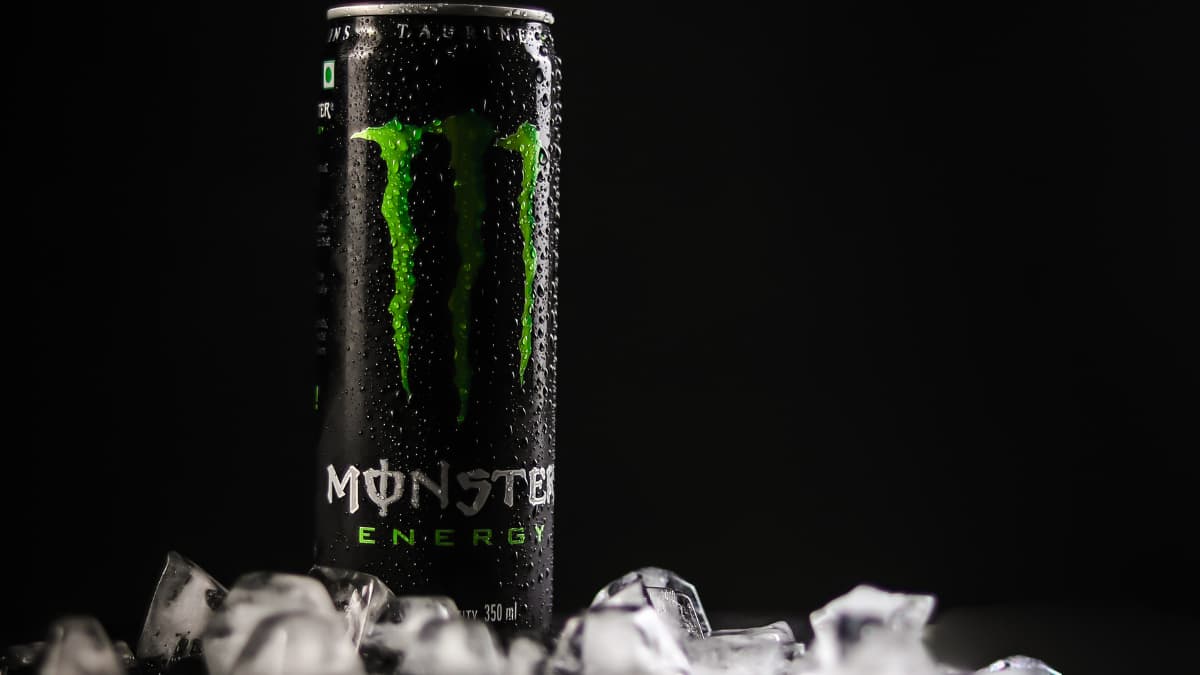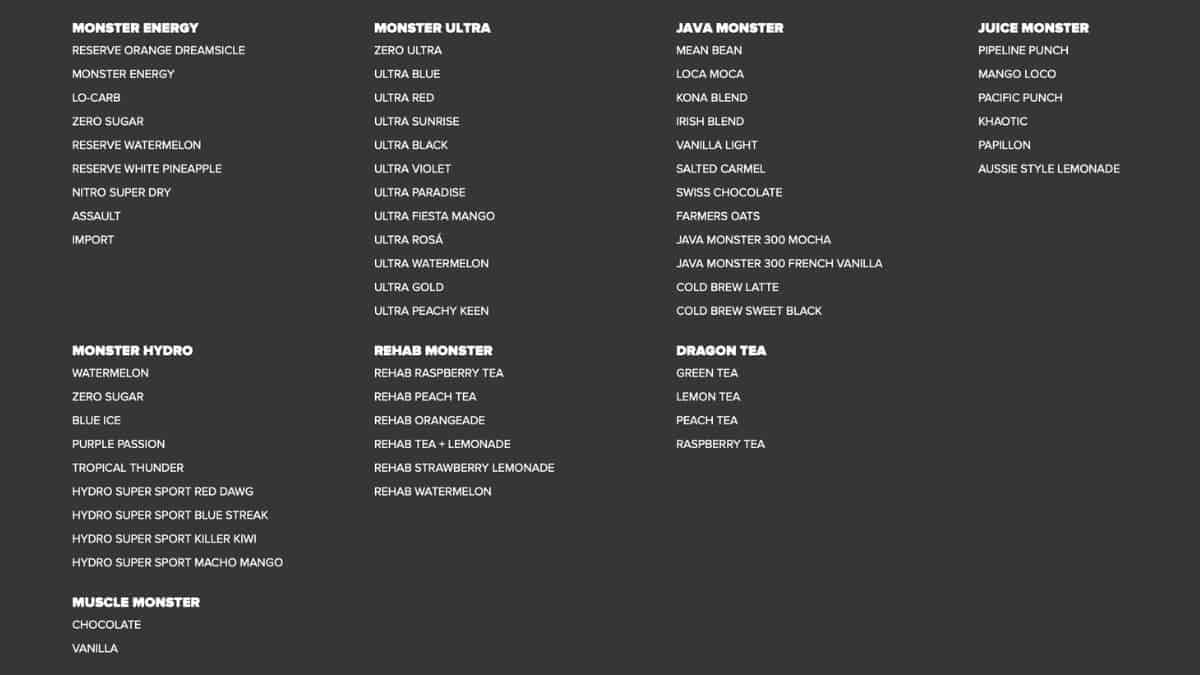How Much Caffeine Is In A Monster Energy Drink?
People around the world rely on energy drinks to help them get through tough workouts. If you need a boost, you might be wondering how to pump it up before you pump that iron.
Can drinking energy beverages help you? And just how much caffeine can you get in an energy drink? Let’s look at a popular beverage brand: Monster Energy Drinks.
So, how much caffeine is in a monster?

How Much Caffeine Is in Monster Energy Drinks?
Where does the energy in an energy drink come from? The main sources of energy in these beverages is from sugars and caffeine.
How much caffeine will you find in these beverages? An 8-ounce serving of Original Monster Energy gives you about 80 mg of caffeine and 27 grams of sugar.
Keep in mind that the number is per serving, not per can. There are two servings in a can. So if you drink a whole can, you get double the amount of caffeine and sugar.
Depending on the particular product you choose, there is a range of caffeine as well as sugar.
Some Monster drinks dip down to 140 mg of caffeine per can, while the Monster Java goes up to a whopping 300 mg per can.
Some Monster Energy drinks have zero sugar. In general, though, the amount of caffeine makes Monster Energy comparable to Red Bull.
Monster Energy offers over 60 drink flavors. Tastes go from fruity juices like watermelon to dessert-like orange creamsicle creations.

Some Monster Energy beverages have natural caffeine. But much of the caffeine content is synthetic. Made in a lab, synthetic caffeine is cheaper and easier to add to food products. It has similar effects on the body as natural caffeine.
Keep in mind, products with synthetic caffeine lack nutrients that benefit your body. They often contain ingredients that you might not want to put in your body. Some of those ingredients are as simple as excess sugars. But others, such as artificial sweeteners and preservatives, might cause harm.
But I get it. Sometimes you just need a quick pick-me-up and you’re gonna go for an energy drink. Let’s take a look at some Monster drinks and the caffeine in the can.
Monster Energy Caffeine Content
Monster Energy comes in several lines. Let’s look at popular options Ultra, Energy, Java, Juice or Muscle Monster, and Hydro.
- Ultra: The Ultra line has zero sugar and varies in caffeine from 140 to 160 mg. It comes in flavors like watermelon, Peachy Keen, or mango.
- Energy: The Monster Energy line has about 160 mg of caffeine per can. Flavors include Orange Dreamsicle, White Pineapple, or nitro.
- Java: Most of the Java line has 200 mg of caffeine per can and has flavors such as Salted Caramel. The Java Monster 300 flavors have 300 mg of caffeine per can.
- Juice: The Juice Monster line mixes carbonated juices with a hit of caffeine, at about 160 mg of caffeine per can.
- Muscle: The Muscle Monster line adds 27 grams of protein to help muscle development. Plus, it comes in around 160 mg of caffeine per can.
- Hydro: The Hydro line has 160 mg per 20-ounce bottle. Not to mention additional electrolytes and B vitamins.
Some Monster Energy drinks also have ingredients like artificial sweeteners, flavors, and preservatives.
Caffeine in Monster VS Coffee
So how do energy beverages stack up to coffee? People often assume that an energy beverage has much more caffeine than coffee. But that’s not necessarily the case.
How much caffeine is in a cup of coffee? An 8-ounce cup of coffee can have between 80 and 200 mg. The exact number varies depending on where the coffee is from and how it’s brewed.
For instance, French Press coffee has a longer brew time than drip coffee. The longer brew time means that coffee made by the French Press method has a higher caffeine content.
If you’re considering espresso as a way to give you a boost, a 1-ounce shot of espresso has about 65 mg of caffeine. That’s a highly concentrated source of caffeine.

To compare, 8 ounces of espresso would have a caffeine content of around 450–500 mg. That’s above the safe daily limits, so we don’t recommend downing 8 ounces of espresso!
But even just a doppio (two shots of espresso) can get you close to the caffeine content in many energy beverages. And there are no sugars or artificial ingredients in that tasty espresso coffee.
But what if you don’t have an espresso machine on hand but still want the most amount of caffeine? Try brewing your coffee in a long immersion method such as a French Press.
You can also choose to drink robusta coffee, which is the coffee species that has more caffeine.
Combine robusta and immersion brew. And voila! You get an intense, delicious cup of coffee with caffeine content similar to a Monster Energy drink. But it also keeps all the antioxidants and other potential health benefits of coffee.
Coffee and energy drinks both can have about the same amount of caffeine per serving. So which should you choose?
Coffee has a distinct advantage over a Monster Energy drink. Coffee has none of the sweeteners or carbs that are often added to Monster beverages. But you still get a similar boost. Also, it contains nutrients and antioxidants which are usually absent in energy drinks.
Do Monster Energy Drinks Help With Working Out?
Say you’re preparing for high-intensity workouts or action sports like mountain biking. You need a quick source of energy to get you through your workout. Energy beverages claim to help boost you through intense exercise.
To understand how they can benefit you, it’s important to understand how long these beverages last in the body. Within about 10 minutes of drinking one, the sugar and caffeine start to work on your body.
But the boost is short-lived. Within an hour, blood sugar and caffeine levels begin to decrease. This sudden dip can cause an energy crash.
Some beverage manufacturers claim that taurine or other amino acids aid exercise recovery. But research studies are inconclusive about the actual benefits of taurine.
The caffeine and sugar in these beverages do provide an initial boost. But these beverages also have sweeteners and other ingredients. These extra ingredients could have a negative impact on your health.
So what’s the alternative to drinking an energy beverage before a workout? Consider drinking tea or taking a pre-workout supplement. Either of these can help you avoid carbs and artificial ingredients.
You can also choose healthy snacks. Fruits, cheese, and nuts can give you a boost with no unwanted side effects.
Wrapping Up: Caffeine in Monster Energy
Remember that healthy adults can safely have up to 400 milligrams of caffeine a day. That’s about 4 cups of brewed coffee.
Large quantities of caffeine can produce unwanted health consequences. These side effects can include heart and breathing problems and extreme anxiety.
People who are sensitive to caffeine (or allergic to it) may need to consume less caffeine. And teenagers should limit their caffeine consumption according to research.
Some Monster Energy drinks give you half that safe daily amount in just one can or bottle. Plan well when considering how much is safe for you.
Some foods, such as chocolate, contain caffeine. The amount of caffeine adds up if you’re also enjoying a Monster Energy drink with those treats.
Want to get your boost from a cup of coffee? I can’t argue with that. Just remember that the caffeine content can vary depending on the brew method and bean type.

